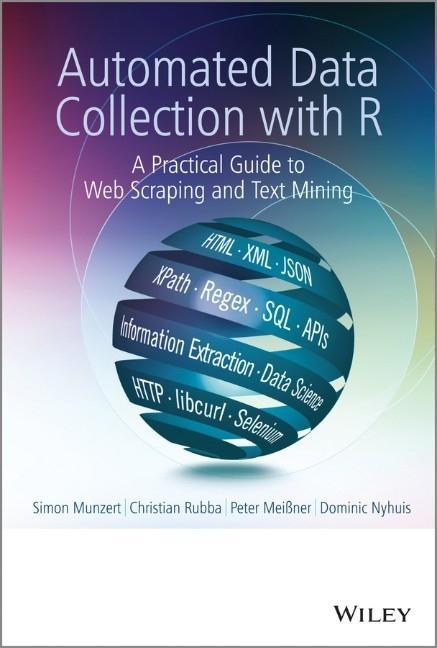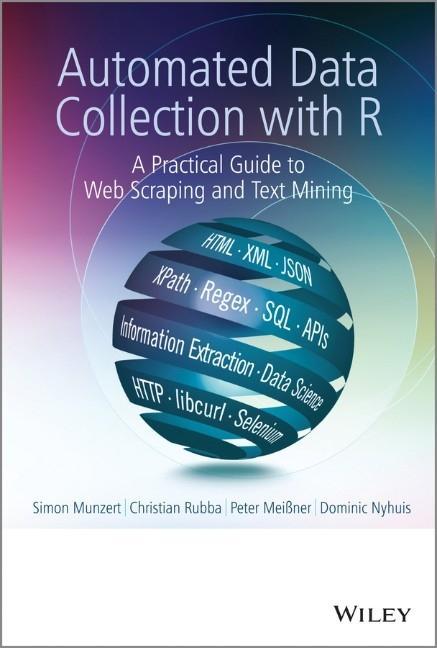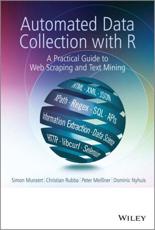
2014, ISBN: 111883481X
[EAN: 9781118834817], Neubuch, [SC: 0.0], [PU: John Wiley & Sons], COMPUTERS - DATA BASE MANAGEMENT DATABASES MINING MATHEMATIK WAHRSCHEINLICHKEITSTHEORIE STOCHASTIK MATHEMATISCHE STATIST… Mehr…
| ZVAB.com moluna, Greven, Germany [73551232] [Rating: 5 (von 5)] NEW BOOK. Versandkosten:Versandkostenfrei. (EUR 0.00) Details... |

ISBN: 9781118834817
*Automated Data Collection with R: A Practical Guide to Web Scraping and Text Mining* - 1. Auflage / gebundene Ausgabe für 104.99 € / Aus dem Bereich: Bücher, Wissenschaft, Mathematik Med… Mehr…
| Hugendubel.de 111883481X. Versandkosten:Shipping in 2 weeks, , Versandkostenfrei nach Hause oder Express-Lieferung in Ihre Buchhandlung., DE. (EUR 0.00) Details... |

Automated Data Collection with R: A Practical Guide to Web Scraping and Text Mining - gebunden oder broschiert
ISBN: 9781118834817
Wiley. Hardcover. GOOD. Spine creases, wear to binding and pages from reading. May contain limited notes, underlining or highlighting that does affect the text. Possible ex library copy… Mehr…
| Biblio.co.uk |

Automated Data Collection with R: A Practical Guide to Web Scraping and Text Mining - gebunden oder broschiert
2015, ISBN: 9781118834817
Wiley, 2015-01-20. Hardcover. Used: Good., Wiley, 2015-01-20, 2.5
| Biblio.co.uk |

| Blackwells.co.uk |


2014, ISBN: 111883481X
[EAN: 9781118834817], Neubuch, [SC: 0.0], [PU: John Wiley & Sons], COMPUTERS - DATA BASE MANAGEMENT DATABASES MINING MATHEMATIK WAHRSCHEINLICHKEITSTHEORIE STOCHASTIK MATHEMATISCHE STATIST… Mehr…

Simon Munzert/ Christian Rubba/ Peter Meißner/ Dominic Nyhuis:
Automated Data Collection with R: A Practical Guide to Web Scraping and Text Mining - TaschenbuchISBN: 9781118834817
*Automated Data Collection with R: A Practical Guide to Web Scraping and Text Mining* - 1. Auflage / gebundene Ausgabe für 104.99 € / Aus dem Bereich: Bücher, Wissenschaft, Mathematik Med… Mehr…
Automated Data Collection with R: A Practical Guide to Web Scraping and Text Mining - gebunden oder broschiert
ISBN: 9781118834817
Wiley. Hardcover. GOOD. Spine creases, wear to binding and pages from reading. May contain limited notes, underlining or highlighting that does affect the text. Possible ex library copy… Mehr…
Automated Data Collection with R: A Practical Guide to Web Scraping and Text Mining - gebunden oder broschiert
2015, ISBN: 9781118834817
Wiley, 2015-01-20. Hardcover. Used: Good., Wiley, 2015-01-20, 2.5
Bibliographische Daten des bestpassenden Buches
| Autor: | |
| Titel: | |
| ISBN-Nummer: |
Detailangaben zum Buch - Automated Data Collection with R: A Practical Guide to Web Scraping and Text Mining
EAN (ISBN-13): 9781118834817
ISBN (ISBN-10): 111883481X
Gebundene Ausgabe
Taschenbuch
Erscheinungsjahr: 2015
Herausgeber: WILEY
Buch in der Datenbank seit 2014-06-11T11:31:45+02:00 (Berlin)
Detailseite zuletzt geändert am 2024-05-07T14:44:51+02:00 (Berlin)
ISBN/EAN: 9781118834817
ISBN - alternative Schreibweisen:
1-118-83481-X, 978-1-118-83481-7
Alternative Schreibweisen und verwandte Suchbegriffe:
Autor des Buches: meissner peter, meißner, christian simon, meisner, munz, münz, szlig, mei, münzer, meiner, peter dominic, john main, nyhuis
Titel des Buches: web, data, collection simon, text mining with
Daten vom Verlag:
Autor/in: Simon Munzert; Christian Rubba; Peter Meißner; Dominic Nyhuis
Titel: Automated Data Collection with R - A Practical Guide to Web Scraping and Text Mining
Verlag: Wiley; John Wiley & Sons
474 Seiten
Erscheinungsjahr: 2014-12-26
Gewicht: 0,878 kg
Sprache: Englisch
65,90 € (DE)
Not available (reason unspecified)
170mm x 244mm x 27mm
BB; Hardcover, Softcover / Mathematik/Wahrscheinlichkeitstheorie, Stochastik, Mathematische Statistik; Wahrscheinlichkeitsrechnung und Statistik; Data Mining; Data Mining Statistics; R (Programm); Research Methodologies; Sociology; Soziologie; Soziologische Forschungsmethoden; Statistical Software / R; Statistics; Statistik; Statistiksoftware / R; Soziologische Forschungsmethoden; Statistiksoftware / R; Data Mining; Data Mining
Preface xv 1 Introduction 1 1.1 Case study: World Heritage Sites in Danger 1 1.2 Some remarks on web data quality 7 1.3 Technologies for disseminating, extracting, and storing web data 9 1.3.1 Technologies for disseminating content on the Web 9 1.3.2 Technologies for information extraction from web documents 11 1.3.3 Technologies for data storage 12 1.4 Structure of the book 13 Part One A Primer onWeb and Data Technologies 15 2 HTML 17 2.1 Browser presentation and source code 18 2.2 Syntax rules 19 2.2.1 Tags, elements, and attributes 20 2.2.2 Tree structure 21 2.2.3 Comments 22 2.2.4 Reserved and special characters 22 2.2.5 Document type definition 23 2.2.6 Spaces and line breaks 23 2.3 Tags and attributes 24 2.3.1 The anchor tag 24 2.3.2 The metadata tag 25 2.3.3 The external reference tag 26 2.3.4 Emphasizing tags , , 26 2.3.5 The paragraphs tag 27 2.3.6 Heading tags , , ,... 27 2.3.7 Listing content with , , and 27 2.3.8 The organizational tags and 27 2.3.9 The tag and its companions 29 2.3.10 The foreign script tag 30 2.3.11 Table tags , , , and 32 2.4 Parsing 32 2.4.1 What is parsing? 33 2.4.2 Discarding nodes 35 2.4.3 Extracting information in the building process 37 Summary 38 Further reading 38 Problems 39 3 XML and JSON 41 3.1 A short example XML document 42 3.2 XML syntax rules 43 3.2.1 Elements and attributes 44 3.2.2 XML structure 46 3.2.3 Naming and special characters 48 3.2.4 Comments and character data 49 3.2.5 XML syntax summary 50 3.3 When is an XML document well formed or valid? 51 3.4 XML extensions and technologies 53 3.4.1 Namespaces 53 3.4.2 Extensions of XML 54 3.4.3 Example: Really Simple Syndication 55 3.4.4 Example: scalable vector graphics 58 3.5 XML and R in practice 60 3.5.1 Parsing XML 60 3.5.2 Basic operations on XML documents 63 3.5.3 From XML to data frames or lists 65 3.5.4 Event-driven parsing 66 3.6 A short example JSON document 68 3.7 JSON syntax rules 69 3.8 JSON and R in practice 71 Summary 76 Further reading 76 Problems 76 4 XPath 79 4.1 XPath--a query language for web documents 80 4.2 Identifying node sets with XPath 81 4.2.1 Basic structure of an XPath query 81 4.2.2 Node relations 84 4.2.3 XPath predicates 86 4.3 Extracting node elements 93 4.3.1 Extending the fun argument 94 4.3.2 XML namespaces 96 4.3.3 Little XPath helper tools 97 Summary 98 Further reading 99 Problems 99 5 HTTP 101 5.1 HTTP fundamentals 102 5.1.1 A short conversation with a web server 102 5.1.2 URL syntax 104 5.1.3 HTTP messages 106 5.1.4 Request methods 108 5.1.5 Status codes 108 5.1.6 Header fields 109 5.2 Advanced features of HTTP 116 5.2.1 Identification 116 5.2.2 Authentication 121 5.2.3 Proxies 123 5.3 Protocols beyond HTTP 124 5.3.1 HTTP Secure 124 5.3.2 FTP 126 5.4 HTTP in action 126 5.4.1 The libcurl library 127 5.4.2 Basic request methods 128 5.4.3 A low-level function of RCurl 131 5.4.4 Maintaining connections across multiple requests 132 5.4.5 Options 133 5.4.6 Debugging 139 5.4.7 Error handling 143 5.4.8 RCurl or httr--what to use? 144 Summary 144 Further reading 144 Problems 146 6 AJAX 149 6.1 JavaScript 150 6.1.1 How JavaScript is used 150 6.1.2 DOM manipulation 151 6.2 XHR 154 6.2.1 Loading external HTML/XML documents 155 6.2.2 Loading JSON 157 6.3 Exploring AJAX with Web Developer Tools 158 6.3.1 Getting started with Chrome's Web Developer Tools 159 6.3.2 The Elements panel 159 6.3.3 The Network panel 160 Summary 161 Further reading 162 Problems 162 7 SQL and relational databases 164 7.1 Overview and terminology 165 7.2 Relational Databases 167 7.2.1 Storing data in tables 167 7.2.2 Normalization 170 7.2.3 Advanced features of relational databases and DBMS 174 7.3 SQL: a language to communicate with Databases 175 7.3.1 General remarks on SQL, syntax, and our running example 175 7.3.2 Data control language--DCL 177 7.3.3 Data definition language--DDL 178 7.3.4 Data manipulation language--DML 180 7.3.5 Clauses 184 7.3.6 Transaction control language--TCL 187 7.4 Databases in action 188 7.4.1 R packages to manage databases 188 7.4.2 Speaking R-SQL via DBI-based packages 189 7.4.3 Speaking R-SQL via RODBC 191 Summary 192 Further reading 193 Problems 193 8 Regular expressions and essential string functions 196 8.1 Regular expressions 198 8.1.1 Exact character matching 198 8.1.2 Generalizing regular expressions 200 8.1.3 The introductory example reconsidered 206 8.2 String processing 207 8.2.1 The stringr package 207 8.2.2 A couple more handy functions 211 8.3 A word on character encodings 214 Summary 216 Further reading 217 Problems 217 Part Two A Practical Toolbox forWeb Scraping and Text Mining 219 9 Scraping the Web 221 9.1 Retrieval scenarios 222 9.1.1 Downloading ready-made files 223 9.1.2 Downloading multiple files from an FTP index 226 9.1.3 Manipulating URLs to access multiple pages 228 9.1.4 Convenient functions to gather links, lists, and tables from HTML documents 232 9.1.5 Dealing with HTML forms 235 9.1.6 HTTP authentication 245 9.1.7 Connections via HTTPS 246 9.1.8 Using cookies 247 9.1.9 Scraping data from AJAX-enriched webpages with Selenium/Rwebdriver 251 9.1.10 Retrieving data from APIs 259 9.1.11 Authentication with OAuth 266 9.2 Extraction strategies 270 9.2.1 Regular expressions 270 9.2.2 XPath 273 9.2.3 Application Programming Interfaces 276 9.3 Web scraping: Good practice 278 9.3.1 Is web scraping legal? 278 9.3.2 What is robots.txt? 280 9.3.3 Be friendly! 284 9.4 Valuable sources of inspiration 290 Summary 291 Further reading 292 Problems 293 10 Statistical text processing 295 10.1 The running example: Classifying press releases of the British government 296 10.2 Processing textual data 298 10.2.1 Large-scale text operations--The tm package 298 10.2.2 Building a term-document matrix 303 10.2.3 Data cleansing 304 10.2.4 Sparsity and n-grams 305 10.3 Supervised learning techniques 307 10.3.1 Support vector machines 309 10.3.2 Random Forest 309 10.3.3 Maximum entropy 309 10.3.4 The RTextTools package 309 10.3.5 Application: Government press releases 310 10.4 Unsupervised learning techniques 313 10.4.1 Latent Dirichlet Allocation and correlated topic models 314 10.4.2 Application: Government press releases 314 Summary 320 Further reading 320 11 Managing data projects 322 11.1 Interacting with the file system 322 11.2 Processing multiple documents/links 323 11.2.1 Using for-loops 324 11.2.2 Using while-loops and control structures 326 11.2.3 Using the plyr package 327 11.3 Organizing scraping procedures 328 11.3.1 Implementation of progress feedback: Messages and progress bars 331 11.3.2 Error and exception handling 333 11.4 Executing R scripts on a regular basis 334 11.4.1 Scheduling tasks on Mac OS and Linux 335 11.4.2 Scheduling tasks on Windows platforms 337 Part Three A Bag of Case Studies 341 12 Collaboration networks in the US Senate 343 12.1 Information on the bills 344 12.2 Information on the senators 350 12.3 Analyzing the network structure 353 12.3.1 Descriptive statistics 354 12.3.2 Network analysis 356 12.4 Conclusion 358 13 Parsing information from semistructured documents 359 13.1 Downloading data from the FTP server 360 13.2 Parsing semistructured text data 361 13.3 Visualizing station and temperature data 368 14 Predicting the 2014 Academy Awards using Twitter 371 14.1 Twitter APIs: Overview 372 14.1.1 The REST API 372 14.1.2 The Streaming APIs 373 14.1.3 Collecting and preparing the data 373 14.2 Twitter-based forecast of the 2014 Academy Awards 374 14.2.1 Visualizing the data 374 14.2.2 Mining tweets for predictions 375 14.3 Conclusion 379 15 Mapping the geographic distribution of names 380 15.1 Developing a data collection strategy 381 15.2 Website inspection 382 15.3 Data retrieval and information extraction 384 15.4 Mapping names 387 15.5 Automating the process 389 Summary 395 16 Gathering data on mobile phones 396 16.1 Page exploration 396 16.1.1 Searching mobile phones of a specific brand 396 16.1.2 Extracting product information 400 16.2 Scraping procedure 404 16.2.1 Retrieving data on several producers 404 16.2.2 Data cleansing 405 16.3 Graphical analysis 406 16.4 Data storage 408 16.4.1 General considerations 408 16.4.2 Table definitions for storage 409 16.4.3 Table definitions for future storage 410 16.4.4 View definitions for convenient data access 411 16.4.5 Functions for storing data 413 16.4.6 Data storage and inspection 415 17 Analyzing sentiments of product reviews 416 17.1 Introduction 416 17.2 Collecting the data 417 17.2.1 Downloading the files 417 17.2.2 Information extraction 421 17.2.3 Database storage 424 17.3 Analyzing the data 426 17.3.1 Data preparation 426 17.3.2 Dictionary-based sentiment analysis 427 17.3.3 Mining the content of reviews 432 17.4 Conclusion 434 References 435 General index 442 Package index 448 Function index 449Weitere, andere Bücher, die diesem Buch sehr ähnlich sein könnten:
Neuestes ähnliches Buch:
9788126570423 Automated Data Collection With R: A Practical Guide To Web Scraping And Text Mining (Simon Munzert And Christian Rubba)
- 9788126570423 Automated Data Collection With R: A Practical Guide To Web Scraping And Text Mining (Simon Munzert And Christian Rubba)
- 9781118834787 Automated Data Collection with R (Simon Munzert; Dominic Nyhuis; Christian Rubba; Peter Mei ner)
- 9781118834800 Automated Data Collection with R (Simon Munzert, Christian Rubba, Peter Meißner, Dominic Nyhuis)
- Automated Data Collection with R: A Practical Guide to Web Scraping and Text Mining (Munzert, Simon, Rubba, Christian, Meißner, Peter, Nyhuis, Dominic)
< zum Archiv...


